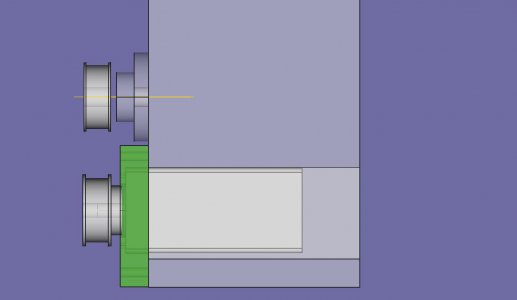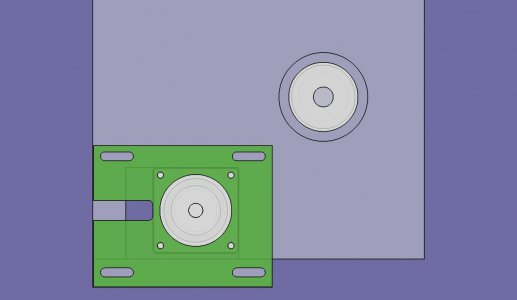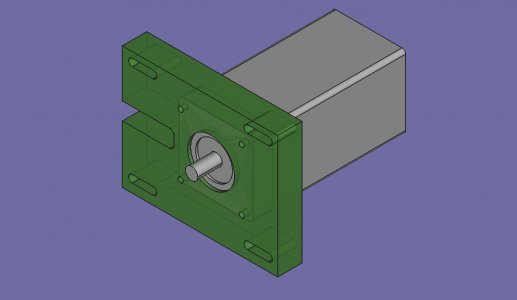-
Welcome back Guest! Did you know you can mentor other members here at H-M? If not, please check out our Relaunch of Hobby Machinist Mentoring Program!
You are using an out of date browser. It may not display this or other websites correctly.
You should upgrade or use an alternative browser.
You should upgrade or use an alternative browser.
Need to fix an eff up, can I fill a hole in cast iron with silicon bronze?
- Thread starter WobblyHand
- Start date
- Joined
- Apr 23, 2018
- Messages
- 6,603
I think the opposite is true. To apply braze with a torch, the base metal has to be red hot, which will take a ton of heat. Tig will focus the heat and require less heat input to flow. But I don't think heat is what you want here, a cold repair is really the way to go.There are many brazing rods out there that can be used with a normal torch...I'd go that route. I have used the Ble Demon triple play. To tig that you'd have to preheat the hell out of it....sounds like a lot of issues to me. I feel your pain, been in similar situation more than once!
- Joined
- Dec 18, 2019
- Messages
- 6,538
I'll have to make the plug on my mini lathe. Have some 1/4" 12L14 rod I can turn and single point to M6. Need to get some red loctite, only have blue kicking around, and it's pretty old.I'd think a threaded plug of some sort might be an option. Use some red lock tite on it and drill a new hole.
Probably also make a couple bushings out of some weldable steel and tack weld them to the plate. Much to my surprise, the only weldable stock I have is 1"x1" A36. Know what I will be doing.
- Joined
- Jun 26, 2018
- Messages
- 1,733
I'm really good at controlling heat input with my TIG, but I don't know about cast iron...I've never done it. Pre heating it then welding it, I assume you'd see temps at 900+. The Triple play melts at 700F and I don't think you need to get the base metal quite that high. It just a thought, but if I were in OP's shoes, I'd do as he did here, someone is bound to have a good answer. I would not want to have to do whatever the answer is sadly...I think the opposite is true. To apply braze with a torch, the base metal has to be red hot, which will take a ton of heat. Tig will focus the heat and require less heat input to flow. But I don't think heat is what you want here, a cold repair is really the way to go.
Even though I love hot work, this is definitely a cold work job. I like the idea of the steel plate or glued plugs. I also like the idea of constantly being reminded that I am human. I had a boss who called me a dangerous, emotionless robot who never makes mistakes.
- Joined
- Dec 18, 2019
- Messages
- 6,538
This all will have to wait a little bit.
Been hanging out with our 2-1/2 year old grandson and he's been taking up 200% of our time! Never seen such a whirlwind. We bought him the RexCavator and he's thrilled with it. Cat Excavator + dinosaur sounds what could be more exciting for his age!
Been hanging out with our 2-1/2 year old grandson and he's been taking up 200% of our time! Never seen such a whirlwind. We bought him the RexCavator and he's thrilled with it. Cat Excavator + dinosaur sounds what could be more exciting for his age!
- Joined
- Feb 13, 2017
- Messages
- 2,138
A late reply, my nature, always behind the 8 ball. . .Looking at the mounting plate, it looks like the motor could be rotated on the plate with a couple of shims. Be that as it may, filling the existing misdrilled holes sounds like a viable option. There may be some problems with the one near the edge that broke through. Using TIG is your option. I am "old school" and don't believe in welding cast iron with any method. Cast iron is brazed, that's just the way it is. Even if it doesn't warp the frame, (unlikely) welding it will make a hell of a hard spot that will break later, usually at the most inconvenient time.
With that all said, there is a point to be concerned about, regardless of what method is finally decided on. If the plug is not the same material as the frame, a drill will drift. It will drift toward the softer metal, the easiest drilling, It may be toward the cast iron, or maybe toward the filler. But it will drift unless held rigidly in a (preferably hardened) guide. Step drilling will help there, but a guide will be necessary for each drill. A carbide drill will help, but still needs a guide.
With the child to occupy your time, there is time to let the problem age a little. When you get back to it, the answer may slap you in the face.
.
With that all said, there is a point to be concerned about, regardless of what method is finally decided on. If the plug is not the same material as the frame, a drill will drift. It will drift toward the softer metal, the easiest drilling, It may be toward the cast iron, or maybe toward the filler. But it will drift unless held rigidly in a (preferably hardened) guide. Step drilling will help there, but a guide will be necessary for each drill. A carbide drill will help, but still needs a guide.
With the child to occupy your time, there is time to let the problem age a little. When you get back to it, the answer may slap you in the face.
.
- Joined
- Dec 18, 2019
- Messages
- 6,538
Have a moment to myself. Here are the drawings for the motor plate. The rectangular motor is inset into the steel plate. Would be a bear to rotate. The inset plus the total thickness of the plate is designed to align the motor pulley with the lead screw pulley.



The slots are to allow tightening of the timing belt. The bottom two screw holes in the lathe casting have problems. The one on the bottom left broke through the edge of the casting on the left. The right bottom one is sloping too down hill and is offset below the slot by a little.
I think I will extend the lower slots towards the center a little, and redrill the bottom holes. I will make two drill guide bushings and tack weld them to the plate. Then mount to the lathe and drill. Once the holes are drilled I can remove the plate and tap the holes. Then remove the drill guides and remount everything. Don't want the fix to depend on me plugging the holes correctly. Maybe I can find some 1/4" cast iron rod? Well - that's not common! Easier to get titanium than small diameter cast iron stock!
I just threw away an imported cast iron xy drill press vise because it is the biggest POS ever. Terrible backlash, not square, etc., etc. Maybe I should fish it out of the bottom of the trash can and slice off a piece and see if I can turn it to 1/4" diameter. Dunno, seems like a fools errand, but won't know until I try. Maybe I can get a small usable piece out of it. Might try that tomorrow after the kids go home.



The slots are to allow tightening of the timing belt. The bottom two screw holes in the lathe casting have problems. The one on the bottom left broke through the edge of the casting on the left. The right bottom one is sloping too down hill and is offset below the slot by a little.
I think I will extend the lower slots towards the center a little, and redrill the bottom holes. I will make two drill guide bushings and tack weld them to the plate. Then mount to the lathe and drill. Once the holes are drilled I can remove the plate and tap the holes. Then remove the drill guides and remount everything. Don't want the fix to depend on me plugging the holes correctly. Maybe I can find some 1/4" cast iron rod? Well - that's not common! Easier to get titanium than small diameter cast iron stock!
I just threw away an imported cast iron xy drill press vise because it is the biggest POS ever. Terrible backlash, not square, etc., etc. Maybe I should fish it out of the bottom of the trash can and slice off a piece and see if I can turn it to 1/4" diameter. Dunno, seems like a fools errand, but won't know until I try. Maybe I can get a small usable piece out of it. Might try that tomorrow after the kids go home.
Attachments
- Joined
- Dec 18, 2019
- Messages
- 6,538
Truly the wisdom of a sage!With the child to occupy your time, there is time to let the problem age a little. When you get back to it, the answer may slap you in the face.
Quite often, it just takes time (or just plain doing something totally different) for the answer to become apparent. Although we are doing other things, somehow we are still subliminally thinking about the problem in the back of our mind. The exposure to other things is sometimes the very thing needed to stimulate our noggins.
Picking up your little grandson and having him fly though the air, repeatedly, giggling and laughing makes one forget everything that you have ever done, or ever will do!
Last edited:
- Joined
- Feb 13, 2017
- Messages
- 2,138
Thank you for the 3D rendition, it seems I was seriously mistook about what you were trying to do. It looks like, if things will clear, you can drill new holes(slots) in the adaptor plate that are offset from the original mounting holes. Then abandon the mis-drilled holes, not bothering to fill or hide them. Clearance for the offset fasteners would be the big issue, making sure the adaptor plate was accessible.
From an earlier photo, it looks like the machine is at least the same general shape(?), form factor(?), whatever as my Taiwan made Grizzly 9 inch. If so, there are some sheet metal covers over the motor area that can be removed, giving good access to the back of the frame. It involves removing a few fasteners but nothing that will change the "character" of the machine. The basic idea being to get the electrics enclosure out of the way so drilling will be true.
.
From an earlier photo, it looks like the machine is at least the same general shape(?), form factor(?), whatever as my Taiwan made Grizzly 9 inch. If so, there are some sheet metal covers over the motor area that can be removed, giving good access to the back of the frame. It involves removing a few fasteners but nothing that will change the "character" of the machine. The basic idea being to get the electrics enclosure out of the way so drilling will be true.
.

